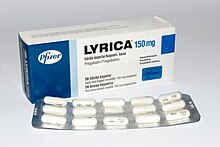Others

| ACSCN | Drug |
|---|---|
| 2710 | Brivaracetam ((2S)-2-[(4R)-2-oxo-4-propylpyrrolidin-1-yl] butanamide)) [6] |
| 2720 | Cenobamate [7] |
| 2779 | Ezogabine [8] |
| 2401 | Ganaxolone [9] |
| 2746 | Lacosamide [10] |
| 2790 | Lasmiditan [11] |
| 2782 | Pregabalin [12] |
This is the list of Schedule V controlled substances as defined by the United States Controlled Substances Act. [1] The following findings are required for substances to be placed in this schedule: [2]
1. The drug or other substance has a low potential for abuse relative to the drugs or other substances in schedule IV.
2. The drug or other substance has a currently accepted medical use in treatment in the United States.
3. Abuse of the drug or other substance may lead to limited physical dependence or psychological dependence relative to the drugs or other substances in schedule IV.
The complete list of Schedule V substances is as follows. The Administrative Controlled Substances Code Number and Federal Register citation for each substance is included.
| ACSCN | Drug |
|---|---|
| N/A | Not more than 200 milligrams of codeine per 100 milliliters or per 100 grams [3] [note 1] |
| N/A | Not more than 100 milligrams of dihydrocodeine per 100 milliliters or per 100 grams [3] [note 1] |
| N/A | Not more than 100 milligrams of ethylmorphine per 100 milliliters or per 100 grams [3] [note 1] |
| N/A | Not more than 2.5 milligrams of diphenoxylate and not less than 25 micrograms of atropine sulfate per dosage unit [3] [note 1] |
| N/A | Not more than 100 milligrams of opium per 100 milliliters or per 100 grams [3] [note 1] |
| N/A | Not more than 0.5 milligram of difenoxin and not less than 25 micrograms of atropine sulfate per dosage unit [4] |
| ACSCN | Drug |
|---|---|
| 1485 | Pyrovalerone [5] |

| ACSCN | Drug |
|---|---|
| 2710 | Brivaracetam ((2S)-2-[(4R)-2-oxo-4-propylpyrrolidin-1-yl] butanamide)) [6] |
| 2720 | Cenobamate [7] |
| 2779 | Ezogabine [8] |
| 2401 | Ganaxolone [9] |
| 2746 | Lacosamide [10] |
| 2790 | Lasmiditan [11] |
| 2782 | Pregabalin [12] |

The Controlled Substances Act (CSA) is the statute establishing federal U.S. drug policy under which the manufacture, importation, possession, use, and distribution of certain substances is regulated. It was passed by the 91st United States Congress as Title II of the Comprehensive Drug Abuse Prevention and Control Act of 1970 and signed into law by President Richard Nixon. The Act also served as the national implementing legislation for the Single Convention on Narcotic Drugs.

Glutethimide is a hypnotic sedative that was introduced by Ciba in 1954 as a safe alternative to barbiturates to treat insomnia. Before long, however, it had become clear that glutethimide was just as likely to cause addiction and caused similar withdrawal symptoms. Doriden was the brand-name version. Current production levels in the United States point to its use only in small-scale research. Manufacturing of the drug was discontinued in the US in 1993 and discontinued in several eastern European countries in 2006.

Carisoprodol, sold under the brand name Soma among others, is a medication used for musculoskeletal pain. Use is only approved for up to three weeks. Effects generally begin within half an hour and last for up to six hours. It is taken orally.

Propylhexedrine, commonly sold under the brand name Benzedrex, is an alkylamine primarily utilized as a topical nasal decongestant. Its main indications are relief of congestion due to colds, allergies, and allergic rhinitis.

HU-210 is a synthetic cannabinoid that was first synthesized in 1988 from (1R,5S)-myrtenol by a group led by Raphael Mechoulam at the Hebrew University. HU-210 is 100 to 800 times more potent than natural THC from cannabis and has an extended duration of action. HU-210 has a binding affinity of 0.061 nM at CB1 and 0.52 nM at CB2 in cloned human cannabinoid receptors compared to delta-9-THC of 40.7 nM at CB1. HU-210 is the (–)-1,1-dimethylheptyl analog of 11-hydroxy- Δ8- tetrahydrocannabinol; in some references it is called 1,1-dimethylheptyl- 11-hydroxytetrahydrocannabinol. The abbreviation "HU" stands for Hebrew University.

In the United States, the removal of cannabis from Schedule I of the Controlled Substances Act is a proposed legal and administrative change in cannabis-related law at the federal level. It has been proposed repeatedly since 1972. The category is the most tightly restricted category reserved for drugs that have "no currently accepted medical use."

Halazepam is a benzodiazepine derivative that was marketed under the brand names Paxipam in the United States, Alapryl in Spain, and Pacinone in Portugal.

Etizolam is a thienodiazepine derivative which is a benzodiazepine analog. The etizolam molecule differs from a benzodiazepine in that the benzene ring has been replaced by a thiophene ring and triazole ring has been fused, making the drug a thienotriazolodiazepine.
Title 21 is the portion of the Code of Federal Regulations that governs food and drugs within the United States for the Food and Drug Administration (FDA), the Drug Enforcement Administration (DEA), and the Office of National Drug Control Policy (ONDCP).

Betahydroxythiofentanyl (β-hydroxythiofentanyl) is an opioid analgesic that is an analog of fentanyl.

The drug policy in the United States is the activity of the federal government relating to the regulation of drugs. Starting in the early 1900s, the United States government began enforcing drug policies. These policies criminalized drugs such as opium, morphine, heroin, and cocaine outside of medical use. The drug policies put into place are enforced by the Food and Drug Administration and the Drug Enforcement Administration. Classification of Drugs are defined and enforced using the Controlled Substance Act, which lists different drugs into their respective substances based on its potential of abuse and potential for medical use. Four different categories of drugs are Alcohol, Cannabis, Opioids, and Stimulants.

The Convention on Psychotropic Substances of 1971 is a United Nations treaty designed to control psychoactive drugs such as amphetamine-type stimulants, barbiturates, benzodiazepines, and psychedelics signed in Vienna, Austria on 21 February 1971. The Single Convention on Narcotic Drugs of 1961 did not ban the many newly discovered psychotropics, since its scope was limited to drugs with cannabis, coca and opium-like effects.

Dexanabinol is a synthetic cannabinoid derivative in development by e-Therapeutics plc. It is the "unnatural" enantiomer of the potent cannabinoid agonist HU-210. Unlike other cannabinoid derivatives, HU-211 does not act as a cannabinoid receptor agonist, but instead as an NMDA antagonist. It therefore does not produce cannabis-like effects, but is anticonvulsant and neuroprotective, and is widely used in scientific research as well as currently being studied for applications such as treating head injury, stroke, or cancer. It was shown to be safe in clinical trials and is currently undergoing Phase I trials for the treatment of brain cancer and advanced solid tumors.
Dronabinol (INN), also known under the trade names Marinol and Syndros, is a generic name for the molecule of delta-9-tetrahydrocannabinol in the pharmaceutical context. It has indications as an appetite stimulant, antiemetic, and sleep apnea reliever and is approved by the FDA as safe and effective for HIV/AIDS-induced anorexia and chemotherapy-induced nausea and vomiting only.

Serdexmethylphenidate is a prodrug of dexmethylphenidate created by the pharmaceutical company KemPharm. The compound was first approved by the FDA as one of the active ingredients in Azstarys for the treatment of attention deficit hyperactivity disorder (ADHD) in children, adolescents, and adults in March 2021. Serdexmethylphenidate is a prodrug which has a delayed onset of action and a prolonged duration of effects compared to dexmethylphenidate, its parent compound.

Thenylfentanyl is an analogue of fentanyl where the phenethylamine side-chain has been replaced by a thiophenylmethyl group. It was temporarily scheduled by the Drug Enforcement Administration in 1985, due to fears it would be used as a designer drug. But in 2010 the DEA acknowledged it was essentially inactive. Subsequently, the substance was since deregulated.